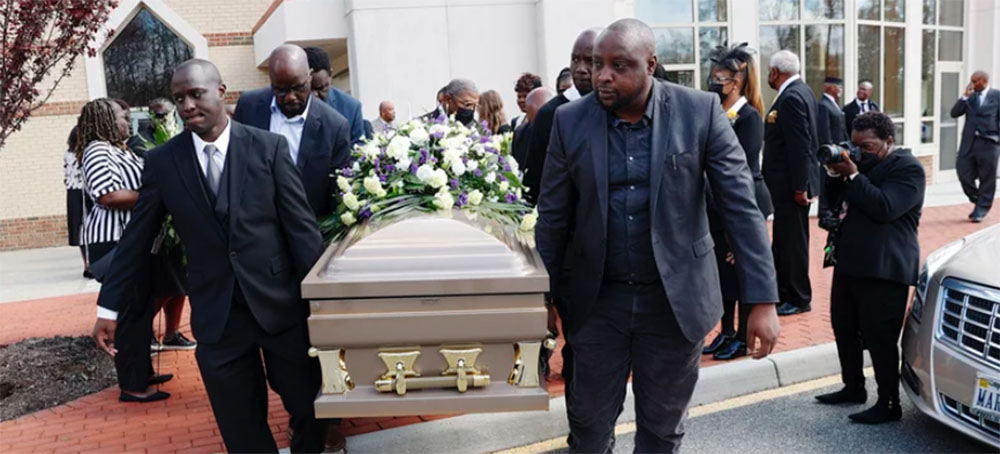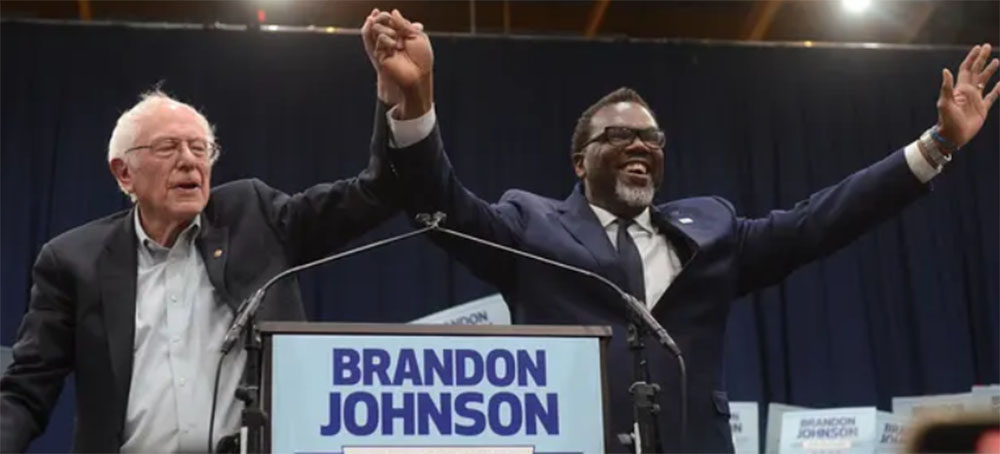Live on the homepage now!
Reader Supported News
ALSO SEE: Trump Charged With Hush-Money Scheme to
Boost 2016 Election Chances
Reuters and others report that should Trump be found guilty of all 34 class E felonies, he could be sentenced to up to 136 years in prison—which, as one former president might tell you, is an incredibly yuge number of years. While a conviction is not a sure thing, and a sympathetic judge could go for the lower end of the sentencing guidelines, Trump, who is 76 years old, would obviously die in prison if he were to get the maximum time behind bars. Which that same former president we referenced earlier would definitely dub “SAD!”
If you’re wondering: Only four states in America allow conjugal visits with one’s spouse, and New York is one of them.
As Manhattan district attorney Alvin Bragg said on Tuesday, the government’s case against Trump is not “just about one payment.” In addition to the $130,000 paid to Stormy Daniels in 2016, the DA’s office cited multiple instances of Trump engaging in “catch and kill“ schemes to bury damaging stories about him that were subsequently concealed through false business entries. Those included $150,000 to Playboy model Karen McDougal, who claimed to have had an affair with Trump, and $30,000 to a New York doorman who’d claimed to have knowledge of a child Trump had out of wedlock.
Trump has pleaded not guilty to all 34 charges.

Crhistian Armando Mamani, a 22-year-old musician, was protesting in a southern city when a bullet entered the left side of his torso and pierced both of his lungs.
The same January day, Roger Rolando Cayo, a 25-year-old protester, died when a shot ripped through his eye and destroyed his brain.
Human rights groups — including the United Nations — have called on the Peruvian government to investigate claims of excessive force used by police and soldiers during recent protests that have left 49 civilians dead, and the autopsies provide some evidence of the alleged use of lethal ammunition.
Thirty of the 32 forensic reports obtained by The Associated Press list gunfire as the cause of death. Some of the reports detail bullet calibers similar to those used by security forces in Peru, which experts believe indicates that police and soldiers violated their own operations manuals prohibiting shooting directly toward protesters unless there’s a serious risk to their life.
The findings come as Peru struggles to recover from the political crisis that hit the country late last year. In December, then-President Pedro Castillo, who was facing several corruption investigations, attempted to dissolve Congress but was instead impeached, arrested and replaced by the vice president. Demonstrations stretched out to February, mostly in southern Peru where the former leader has had more support, triggering the worst political violence the country has seen in more than two decades.
In the southern city of Juliaca, protesters clashed with police outside the airport on Jan. 9 in what would be the deadliest demonstration. Autopsies confirmed that 18 people died from gunfire that day. Among the dead were a 16-year-old student whose left lung was perforated by a 7.62 mm bullet that lodged in his abdomen and a 17-year-old university student who died from a 9 mm bullet wound.
The AP obtained a copy of a document from the federal prosecutor's office that listed the weapons used by police in Juliaca in December, including 7.62 mm AKM assault rifles and 9 mm Beretta and Sauer handguns.
In Peru, civilians are only permitted to own guns with low calibers. High-caliber guns — including the 7.62 and 5.56 mm types mentioned in the forensic reports — are exclusively for the use of security forces.
Carmen Rosa Cardoza, a Peruvian forensic anthropologist, told the AP that the autopsies show a pattern of a “disproportionate use of force.”
“In the injuries by the firearm projectiles, there’s a pattern linked to human rights violations,” she said, noting that most of the fatal wounds are on the head, neck, thorax and abdomen. The shooters, she said, “are targeting those regions.”
Protesters are still staging roadblocks in some parts of the country and calling for the resignation of the new president, Dina Boluarte, whom they blame for the deaths of dozens of demonstrators in areas inhabited largely by Indigenous people.
The attorney general’s office has launched an investigation — including Boluarte — that hasn’t led to any arrests.
“These numbers turn Peru into a champion of repression, when compared to other democracies in Latin America” said Jo-Marie Burt, a Peru expert at the Washington Office on Latin America, a human rights group. “Only openly authoritarian nations like Venezuela and Nicaragua” have had more deaths during recent protests, she said.
Peruvian government officials have not responded AP's request on whether they gave police orders to shoot at protesters after massive demonstrations broke out in the south, where Castillo’s removal angered people frustrated with the nation’s Congress, which has contributed to the political instability by having had six presidents in the past six years and has become one of the nation’s least trusted institutions.
Boluarte has blamed “radicals” linked to illegal mining and the drug trade for the chaotic protests, which have included the occupation of airports and attacks against police bases. But the autopsies, videos and witness testimonies paint a different picture of the violence, in which the nation’s security forces also appear to have had a significant role.
On Dec. 15, demonstrators gathered outside the Ayacucho airport, where security camera videos show soldiers firing Galil rifles horizontally instead of pointing the weapons upward, away from protesters. Forensic reports show 10 protesters died from gunfire in Ayacucho that day, although none of the corpses contained bullets.
Three days later, an AP reporter walked through the area where the shots were fired and found several cases for the 5.56 mm ammunition used with Galil rifles on the floor.
In Andahuaylas, another southern city, 18-year-old protester Wilfredo Lizarme was killed by a bullet to his back on Dec. 11, according to forensic reports. His sister, Carla, found a shell casing close to his body with the legend “PNP 7,62x39,” the initials of Peru’s national police and the same caliber as the bullets used by police in other parts of the country.
The AP has repeatedly sought a response from Peru’s government about the allegations of police violence against protesters but has yet to receive one.
In a January news conference, Boluarte evaded questions about whether she ordered the police to use firearms to break up protests and said that police officers had conducted themselves in an “immaculate” manner.
Police say officers have been trying to defend themselves from violent protesters who have attacked them with improvised weapons, including slingshots and fireworks launched from metal tubes. According to Peru’s National Police, 43 police stations were attacked over the past three months and more than 850 officers sustained injuries during the protests, while one officer was burned alive inside his patrol car in Juliaca.
However, human rights group contend that police haven't followed all regulations.
Mar Pérez, a researcher for the Peruvian National Coordinator for Human Rights group, said that the manual for use of force stipulates that officers can only use firearms and shoot to kill when their lives are at risk.
The fact that there are violent people in a protest doesn’t justify the use of firearms or authorize police to dissolve the entire protest, said Paulo Abrao, a former executive secretary of the Inter-American Commission on Human Rights.
The Interamerican Commission on Human Rights requested in January that Peru’s government launch an inquiry into the use of weapons by police during the protests. Then, in the last week of February, the U.N. High Commissioner for Human Rights sent a document to Peru’s government that expressed the organization’s concern with the deaths of protesters and gave the government 60 days to provide more information on what it is doing to investigate the killings and implement policies that prevent the excessive use of force in protests.
The National Coordinator for Human Rights says that since 2003, it has documented 160 deaths during protests in Peru. Pérez said that “not a single police officer” has been convicted in these killings.
READ MORE  The casket of Irvo Otieno is carried out of First Baptist Church of South Richmond on March 29 after the celebration of life for Irvo Otieno in North Chesterfield, Va. The 28-year-old Black man died after he was pinned to the floor by seven sheriff's deputies and several others while he was being admitted to a mental hospital. (photo: Eva Russo/Richmond Times-Dispatch/AP)
The casket of Irvo Otieno is carried out of First Baptist Church of South Richmond on March 29 after the celebration of life for Irvo Otieno in North Chesterfield, Va. The 28-year-old Black man died after he was pinned to the floor by seven sheriff's deputies and several others while he was being admitted to a mental hospital. (photo: Eva Russo/Richmond Times-Dispatch/AP)
Arkuie Williams, the administrative deputy in the state Office of the Chief Medical Examiner, confirmed the cause of death findings to The Associated Press after attorneys for Otieno's family first shared them in a statement. The manner of death was homicide, Williams wrote in an email.
Otieno, who struggled with mental illness, died March 6 after he was pinned to the floor while being admitted to Central State Hospital in Dinwiddie County.
Video released earlier this month showed sheriff's deputies and hospital employees restraining a handcuffed and shackled Otieno for about 20 minutes after he was forcibly led into a hospital room. For much of that time, Otieno was prone on the floor, pinned by a group so large it blocked the camera's view of him at times.
Personnel who realized he appeared limp and lifeless eventually began resuscitation efforts, the video showed.
"The official cause and manner of death is not surprising to us as it corroborates what the world witnessed in the video," family attorneys Ben Crump and Mark Krudys said in a statement. "In a chilling parallel to George Floyd's killing, Irvo was held down and excessively restrained to death, when he should have been provided medical help and compassion. It is tragic that yet another life has been lost to this malicious and deadly restraint technique."
Seven deputies and three hospital workers have been charged with second-degree murder in Otieno's death.
The local prosecutor who brought the charges has previously said in court that Otieno was smothered to death.
No additional information from the autopsy beyond the cause and manner of death can be released by the medical examiner's office, Williams said.
Otieno was laid to rest last week. Civil rights leader the Rev. Al Sharpton and other speakers at his funeral said his death shows the need for mental health and policing reforms.
Otieno's family and their attorneys have said Otieno was experiencing mental distress at the time of his initial encounter with law enforcement, days before he was taken to the state hospital. He was first taken into police custody in Henrico County March 3, when he was transported to a local hospital for mental health treatment under an emergency custody order.
Police have said that while at the local hospital, he "became physically assaultive toward officers," at which point they arrested him and took him to a local jail, something Otieno's family says should never have happened given that he was in need of treatment. On the afternoon of March 6, he was transferred to the state hospital, which has a unit that provides care for people admitted from jails or by court order.
Some of the attorneys for the defendants charged in his death have said their clients were only trying to restrain Otieno. Otieno's family and their attorneys have said he posed no danger to them and was simply trying to breathe during the encounter at the hospital shown on video.
All defendants have been granted bond and court records show pre-trial hearings in April or May.
AP sought comment on the medical examiner's findings from defense attorneys for each of the defendants. Attorneys Emily Munn, Emilee Hasbrouck and G. Russell Stone, declined to comment.
Attorney Ed Riley, who represents one of the deputies, said he couldn't comment on the merits of the findings without having seen the full autopsy report. He said he worried that public statements from the attorneys for Otieno's family as well as other public disclosures in the case, including the video, could hinder the defendants' right to a fair trial.
Other attorneys did not respond to phone and email messages seeking comment.
READ MORE Juvenile fall-run Chinook salmon at the Coleman National Fish Hatchery in Anderson, Calif. (photo: NYT)
Juvenile fall-run Chinook salmon at the Coleman National Fish Hatchery in Anderson, Calif. (photo: NYT)
The reason: An alarming decline of fish stocks linked to the one-two punch of heavily engineered waterways and the supercharged heat and drought that come with climate change. There are new threats in the ocean, too, that are less understood but may be tied to global warming, according to researchers.
Scientists and fishers had been braced for bad numbers. Conditions were terrible a couple of years earlier, when the salmon were young and tiny in low, overheated creeks and rivers in California. But as the fish counts came in and the models spit out figures, the numbers were even more dismal than expected.
READ MORE  Wisconsin Supreme Court candidate Janet Protasiewicz votes at Franklin City Hall on April 4. (photo: Evelyn Hockstein/Reuters)
Wisconsin Supreme Court candidate Janet Protasiewicz votes at Franklin City Hall on April 4. (photo: Evelyn Hockstein/Reuters)
Milwaukee County Judge Janet Protasiewicz’s victory over former state Supreme Court justice Daniel Kelly will end 15 years of conservative control of the Wisconsin Supreme Court. She could face ethical questions when the court takes up politically charged cases because she campaigned heavily on abortion rights and repeatedly called the state’s election maps “rigged.”
Protasiewicz beat Kelly by 11 points, 55.5 percent to 45.5 percent, according to the Associated Press. About 1.8 million people voted, nearly 40 percent of the state’s eligible voters, which was high given that court elections rarely see turnout of more than 30 percent.
The candidates, political parties and independent groups spent more than $40 million on the race, making it the most expensive judicial contest in U.S. history. It more than quadrupled the amount spent in Wisconsin’s 2020 state Supreme Court race.
Judicial candidates in Wisconsin do not run with party labels, but the race was steeped in partisanship. The state Democratic Party gave nearly $9 million to Protasiewicz, while arms of the Republican Party gave more than $500,000 to Kelly and GOP megadonor Richard Uihlein spent nearly $6 million to help him, according to campaign finance records.
At Protasiewicz’s victory party in downtown Milwaukee, the three liberals who sit on the court marched into the hotel ballroom arm in arm to Lizzo’s “About Damn Time.” They later joined Protasiewicz onstage, and the four of them — the court’s incoming majority — held their hands aloft as the crowd chanted “Janet!”
“Today’s results show that Wisconsinites believe in democracy and the democratic process,” Protasiewicz said. “Today I’m proud to stand by the promise I made to every Wisconsinite that I will always deliver justice and bring common sense to our Supreme Court.”
On Tuesday night, Kelly accused Protasiewicz of spreading “rancid slanders” and said he did not have a “worthy opponent to which I can concede.” He said he respected the voters’ decision but feared for the future of the court.
“I wish Wisconsin the best of luck because I think it’s going to need it,” he said, speaking from a rural, lakeside hotel 70 miles north of Madison.
Protasiewicz will start her 10-year term in August. She will replace Justice Patience Roggensack, a conservative who decided not to seek a third term after 20 years on the court. The next race for a seat on the court is in 2025, when liberal Justice Ann Walsh Bradley’s term ends.
As Wisconsin voters cast their ballots, former president Donald Trump appeared in a Manhattan courtroom and pleaded not guilty to 34 felony counts related to payments intended to silence an adult-film actress during his 2016 presidential campaign. Trump endorsed Kelly in 2020 but stayed out of this year’s race.
Protasiewicz and her allies had a fundraising edge and structured their campaign spending to run about three times as many ads as conservatives in the final weeks of the campaign, according to the media-tracking firm AdImpact. That’s because Democrats took advantage of a campaign finance law written by Republican lawmakers in 2015 that let them funnel huge sums to Protasiewicz, who qualified for the cheapest ad rates because she was a candidate for office. Conservatives ran most of their ads through independent groups that pay far more for ads.
Conservatives won a majority on the court in 2008 and over the next decade and a half issued rulings that upheld limits on unions, approved a voter ID law, ended a campaign finance investigation of Republicans, outlawed absentee-ballot drop boxes and adopted election maps that assured Republicans have commanding majorities in the state legislature.
Kelly joined the court in 2016, when the Republican governor at the time, Scott Walker, appointed him to fill a vacancy. He lost the seat by 10 points in 2020 but hoped to rejoin it this year.
Protasiewicz, 60, was raised in Milwaukee’s working-class south side, graduated from the University of Wisconsin at Milwaukee and got her law degree from Marquette University in Milwaukee. She served as a prosecutor for more than 25 years before becoming a judge nearly 10 years ago. On the campaign trail, she often noted that the only client she ever had as a lawyer was the state.
Protasiewicz had the advantage in the race from the start. She got in early, raised $14 million over the next year and a half, and got Democrats to coalesce around her even though another liberal was also running. She came in first in the February primary with 47 percent. Kelly was second with 24 percent, edging out conservative Waukesha County Circuit Court Judge Jennifer Dorow by two points. (The other liberal in the race, Dane County Circuit Court Judge Everett Mitchell, received about 8 percent.)
Some conservatives feared all along that Kelly would have a tough time this year, citing his loss in 2020 and a string of writings that expressed opposition to abortion and called affirmative action and slavery morally the same.
Protasiewicz made abortion rights the centerpiece of her campaign. Democrats have found the issue resonates with voters since the U.S. Supreme Court in June overturned Roe v. Wade, the 1973 ruling that guaranteed access to abortion across the nation.
When the ruling came down, abortion providers in Wisconsin stopped offering the procedure because of an 1849 law that bans abortion unless one is required to save the life of the mother. A trial judge is slated to hear a challenge to the law next month, and the case is expected to eventually reach the state Supreme Court.
“I can tell you with certainty that if I’m elected on April 4th, I’m sure that we will be looking — I am sure we will be looking — at that 1849 law,” Protasiewicz said at a campaign stop in March in eastern Wisconsin.
She added: “I believe in a woman’s right to choose.”
Over the next two years, the state high court could be called on to decide a host of voting rules for the 2024 presidential election. And the justices could be dragged into challenges over the results of that election, as they were in 2020. Last time, conservative Justice Brian Hagedorn joined the court’s liberals to issue a string of 4-3 rulings that rejected challenges from Trump and his allies over Joe Biden’s win in the state.
Liberal groups are now preparing to file a lawsuit challenging the legislative and congressional districts that conservatives on the Wisconsin Supreme Court approved last year. Those maps so heavily favor Republicans that they have been able to gain nearly two-thirds of the seats in the state legislature even though Wisconsin is nearly evenly split between Democratic and Republican voters.
Even if the court acts quickly, it may not be able to draw new maps in time for the 2024 election. New maps would need to be set by next spring, just six months after Protasiewicz is sworn in. Ordinarily, redistricting challenges take years.
Protasiewicz will face tough questions when the court addresses the abortion and redistricting challenges. Critics have argued she cannot ethically participate in those cases after so clearly spelling out her views.
During the campaign, Republicans filed a complaint against her with the state’s judicial ethics commission. The commission moves slowly and has not said whether it believes she has broken any rules. Republicans have made clear they’re ready to file more complaints.
The commission’s powers are limited, however, and only the state Supreme Court can impose discipline on a justice for violating the judicial ethics code. The conservatives on the court would need to get at least one vote from the liberals to discipline Protasiewicz.
Protasiewicz has said she would not participate in cases brought by the state Democratic Party since it donated so much money directly to her campaign. But she has said she is inclined to remain on the abortion case and would likely participate in a redistricting case if someone other than the state Democratic Party brought it.
Protasiewicz was able to speak so freely about her views on abortion and redistricting during the campaign because of a 2002 U.S. Supreme Court decision. Acting on a lawsuit brought by the Republican Party of Minnesota, the conservative majority in a 5-4 ruling determined judicial candidates have a First Amendment right to express their views on political issues so long as they don’t promise to rule in a particular way.
But having now spelled out her views, Protasiewicz could face challenges over whether she can be impartial, said Charles Geyh, an Indiana University law professor who has written extensively on judicial ethics.
“If she is then called upon to resolve the redistricting matter, where she is on record saying it’s rigged, I have a hard time saying that she shouldn’t disqualify herself from that,” he said.
In Wisconsin, justices decide on their own whether they can participate in cases. That’s in part because conservatives on the court in 2009 ruled the justices could not force one of their colleagues off a case.
Eric H. Holder Jr., who served as attorney general under President Barack Obama, spent Saturday campaigning for Protasiewicz as the head of the National Democratic Redistricting Committee. In an interview, he contended Protasiewicz could remain fair on a redistricting challenge despite her comments in recent months.
“She has said the maps are not necessarily good, but she hasn’t said she would vote in a particular way with regard to a case that was brought before her,” he said. “And you have to look at what the case is, what’s the basis for the complaint that might be filed, and I’m confident that she can do so in an impartial way.”
READ MORE  Brandon Johnson won the election for Chicago mayor Tuesday evening, pulling ahead of his centrist opponent Paul Vallas. (photo: Anadolu Agency)
Brandon Johnson won the election for Chicago mayor Tuesday evening, pulling ahead of his centrist opponent Paul Vallas. (photo: Anadolu Agency)
Election had pit Johnson, who previously supported defund the police, against the centrist Paul Vallas, who was endorsed by the police union
At 10pm, with 91% of the votes in, Johnson led at 51.4% to Vallas’ 48.6%. That amounted to almost 16,000 votes.
The election had pit two Democrats from the furthest ends of their party’s spectrum against each other. Public safety has been the number one issue and Democrats across the country were watching to see if Johnson, a progressive who has previously supported the defund the police movement, could defeat Vallas, who nabbed the endorsement of Chicago’s police union and once described himself as a Republican.
At Vallas’ campaign party in downtown Chicago on Tuesday evening, the once buoyant party had deflated as the results rolled in. Around 8pm a bagpipe band loudly rehearsing in a hotel banquet hall was interrupted by Alderman Brian Hopkins, who said the mood in the room was so grim that the group should pack it up and go home.
Johnson and Vallas had gone head-to-head after a crowded mayoral primary in February. In that race, incumbent mayor Lori Lightfoot won voters in Chicago’s majority Black wards on the south and west side communities while Congressman Jesús “Chuy” García won Latino voters on the west side. Those votes were up for grabs on Tuesday.
Despite high rates of early voting, election day turnout was reportedly “sleepy”. Even so, young voters seemed to have outpaced previous election records, possibly spurring the boost for Johnson.
Earlier in the day, voters lined up in the sprawling 19th ward where about 65% of the 19th’s residents are white and 25% Black, making it one of the more racially diverse areas of a very segregated city. Race and personal identity played a role for some voters at the ballot box.
“I just felt like Vallas was prejudiced,” said Paulette Traylor, who cast her vote in the Beverly neighborhood in the ward. “I really don’t think he cares for Black people. I think he’s more of a Republican and I’m not a Republican.”
As a Black woman and one of nine children, Traylor said she also identified with Johnson’s upbringing. The son of a Black pastor, Johnson often cited his position as a middle child of 10 children as the key to his negotiating skills.
In his hometown neighborhood of Austin on the west side, voters touted Johnson’s messaging on mental health and education. Emily Lucas, an Austin resident, pointed to Vallas’ tenure as Chicago Public Schools CEO as a turnoff, and appreciated that Johnson was a local.
“It would be nice to have a mayor who lived down the street,” said Emily Lucas, an Austin resident. “What an advantage. He’s a hometown guy.”
READ MORE  A herd of caribou graze by the Trans-Alaska Pipeline at the North Slope on Prudhoe Bay, Alaska. (photo: Joel W. Rogers/Corbis Documentary)
A herd of caribou graze by the Trans-Alaska Pipeline at the North Slope on Prudhoe Bay, Alaska. (photo: Joel W. Rogers/Corbis Documentary)
The lawsuit initially filed by the groups asserted that the U.S. Department of the Interior’s approval on March 13 of the Willow project was unlawful because it did not consider reasonable alternatives to limit the harm the project would do to environmentally sensitive areas, and it failed to sufficiently consider future greenhouse gas emissions that would result from the fossil fuel extractions of the project.
“It’s heartbreaking that ConocoPhillips has been allowed to break ground on Willow before the court has fully assessed whether the project is lawful,” said Kristen Monsell, a senior attorney at the Center for Biological Diversity, in a press release. “But this case isn’t over, and we’ll keep fighting to protect struggling Arctic wildlife and our climate from this disastrous project. We’re hopeful we’ll get the Willow project’s approval thrown out once again.”
The lawsuit was filed by the Center for Biological Diversity and the Natural Resources Defense Council, as well as by Earthjustice on behalf of Friends of the Earth, Defenders of Wildlife and Greenpeace.
The mining and construction plans are scheduled for the winter habitat of high numbers of caribou, and will disrupt them.
The planned fossil fuel extraction by ConocoPhillips in the Willow project area amounts to 600 million barrels of oil, in addition to as many as three billion barrels of oil planned for the region.
“Allowing ConocoPhillips to bulldoze forward with construction of the largest oil and gas project on public lands before the lawsuits are settled is needlessly destructive,” said Natalie Mebane, climate campaign director at Greenpeace USA, in the press release. “As the largest historical emitter of greenhouse gas emissions, the U.S. cannot afford Willow or any new oil and gas projects if we’re going to avoid the worst impacts of the climate crisis. New projects will take years if not decades to complete. They do nothing to meet current energy needs. It will only deepen our dependence on expensive fossil fuels while destroying our climate, harming our health, and polluting communities.”
U.S. District Judge Sharon Gleason in Anchorage said the groups pursuing an injunction would not be irreparably harmed by the construction and that an injunction was inappropriate, reported Reuters.
“Although the White House and Department of Interior were not persuaded to stop Willow despite the advocacy of more than 5 million individuals, we are now using the power of the law to restore some balance. While this particular round of the legal challenge did not produce the outcome we had hoped for, our court battle continues,” said Erik Grafe, deputy managing attorney in Earthjustice’s Alaska Regional Office, in the press release. “We will do everything within our power to protect the climate, wildlife, and people from this dangerous carbon bomb. Climate scientists have warned that we have less than seven years to get it right on climate change, and we cannot afford to lock in three decades of oil drilling that will only serve to open the door to more fossil-fuel extraction.”
Nicole Whittington-Evans, Defenders of Wildlife’s Alaska Program director, said the environmental groups would keep fighting.
“Today’s decision is a disappointment, but we remain undeterred,” Whittington-Evans said in the press release. “We remain committed to protecting the western Arctic and look forward to the court’s full consideration of the Willow project, including its impacts to polar bears threatened with extinction and massive carbon emissions that will worsen the climate crisis for decades to come.”
Follow us on facebook and twitter!
PO Box 2043 / Citrus Heights, CA 95611



No comments:
Post a Comment
Note: Only a member of this blog may post a comment.